The ultimate guide to property investment accounting - know your return
There are a lot of things that go into successful property investment. However, one element that is often overlooked is the accounting side of things.
Property investors who understand the advanced concepts of property investment accounting can make more informed decisions about their investments and maximise their returns.
Here you can explore some of the more complex aspects of property investment accounting and how they can benefit you as an investor. So if you're ready to take your investing skills to the next level, keep reading!
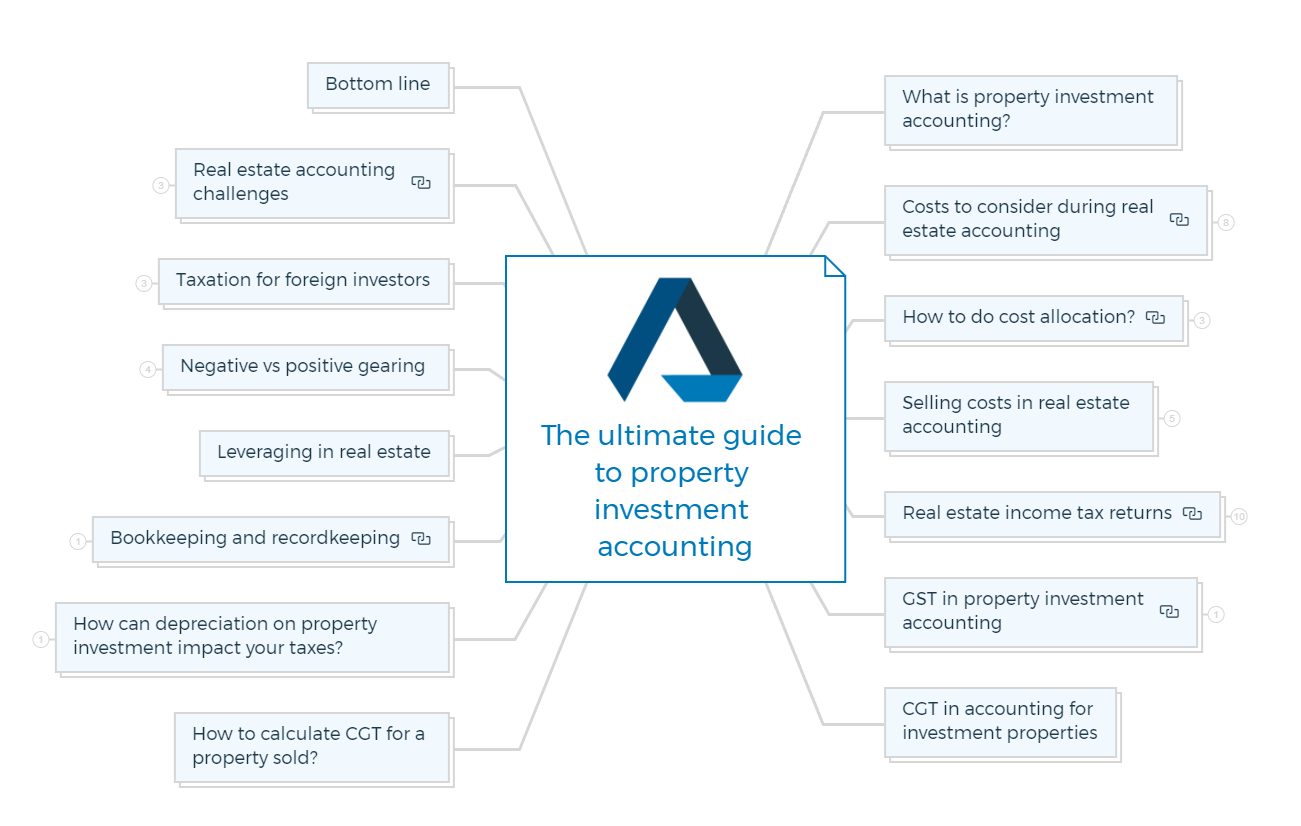
What is property investment accounting?
Property investment accounting is tracking and managing the financial aspects of your property portfolio. It includes recording income and expenses, calculating tax liabilities, and preparing financial statements.
It's important to keep on top of your property investment accounting. It will give you a clear picture of your financial situation and help you make informed decisions about your investments.
Costs to consider during real estate accounting
Here are some considerations that you should follow while accounting for an investment property.
- The acquisition should be investment-driven and not tax-driven.
- Property is an investment that pays off over time. With this in mind, seek counsel from a tax professional on how to organize the ownership.
- Consider your situation before deciding whether or not an interest-only loan is good for you.
- A property in a favorable location without non-cash deductions may produce a greater long-term return than one in a less affluent or profitable location with non-cash deductions.
- The benefits of hiring a real estate agent to handle your property should exceed the disadvantages.

1. Pre-acquisition costs
Costs incurred for the purpose of, but before the purchase of real estate are considered pre-acquisition costs.
They include a wide range of expenses, such as:
- Payments to obtain an option
- Legal fees
- Architectural fees
- Additional professional fees
- Environmental research costs
- Appraisal expenses
- Survey expenses
- Costs of planning and design
- Zoning and traffic studies costs
- Costs of feasibility studies

Capitalisation of pre-acquisition costs
All additional pre-acquisition costs (excluding option costs) must be capitalised if the property (or an option to purchase it) is probable and the costs meet the following criteria:
- The costs must be linked to the property.
- If you had already purchased the property, the costs would be capitalised.
The project is not regarded as probable if the purchaser is not actively looking to acquire the property, cannot finance or secure financing for the property, or if the property is not expected probable.
- Any costs incurred before a project is assessed must be expensed as incurred.
- Costs incurred before the project becomes probable cannot be capitalised if the project becomes probable afterwards.
Pre-acquisition costs that match the criteria mentioned above are capitalised.
- Capitalised pre-acquisition costs are included in project costs once the property is acquired.
2. Project costs
Costs explicitly associated with the acquisition, development, and building of a property project are project costs and can be capitalised.
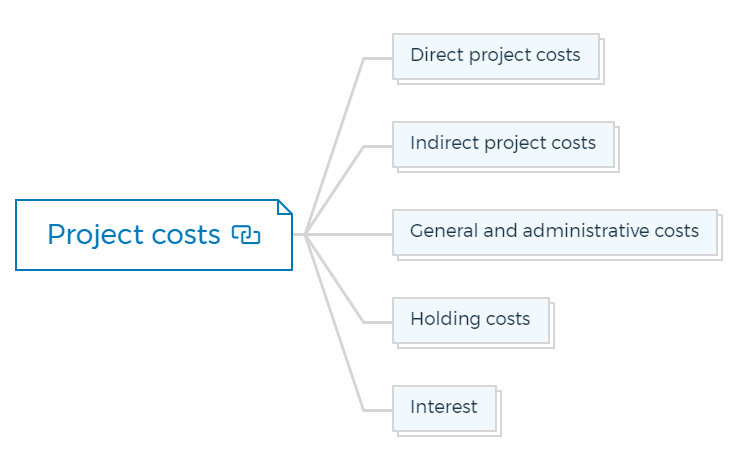
Direct project costs
Direct project costs are additional expenses directly tied to the property's acquisition, development, and construction.
Direct project costs include:
- Purchase cost
- Expenses owed to other parties.
- Fees owed to other parties for brokerage services
- Title search and title guarantee fees
- Construction-related real estate taxes
- Expenses for construction-related insurance
- Permit charges
- Engineering costs
- Costs of demolition
- Costs of construction (materials, labour)
- Amenities cost
- Donated property
Indirect project costs
Indirect project costs are capitalised if directly related to the acquisition, development, or building of a real estate project.
Indirect project costs include:
- Planning department costs
- Construction administration costs (for example, the costs of a field office on a project site)
- Costs incurred internally for cost accounting or project design
- Depreciation of directly used construction machines and equipment
- Employee perks and payroll expenditures for those working on the project
A cost accounting system and proper documentation are required to support cost capitalisation of internally incurred indirect costs.
General and administrative costs
Indirect costs, such as general and administrative expenses that do not relate to projects under development or construction, are charged to expenses as incurred without more direction on which expenses might be deemed general and administrative expenses.
Executive management, corporate accounting, acquisitions, office management and administration, marketing, human resources, and similar costs and services should all be charged to expense as they are incurred.
Holding costs
Property taxes, insurance, and interest come under holding costs. Taxes and insurance are capitalised as part of the property's cost during the preparation phase.
Interest
Real estate developments demand large sums of finance, and financing is a substantial expense. If unfinished real estate is purchased, interest expense incurred during development and construction is capitalised.
Interest capitalisation reflects the company's involvement in the real estate asset. As a result, when a real estate project is impaired, the interest projected to be capitalised in future periods is added to the write-down.
A real estate project's capitalisation rate is determined in four steps:
- Step 1: Determine eligibility for interest capitalisation.
- Step 2: Identify eligible expenses for interest capitalisation.
- Step 3: Choose a capitalisation period.
- Step 4: Calculate the capitalised interest cost.
How to do cost allocation?
Choosing the best cost allocation strategy takes experience. You should allocate costs to those parts of a project that benefit from them. The goal is to maintain a consistent gross margin on sales throughout the project.
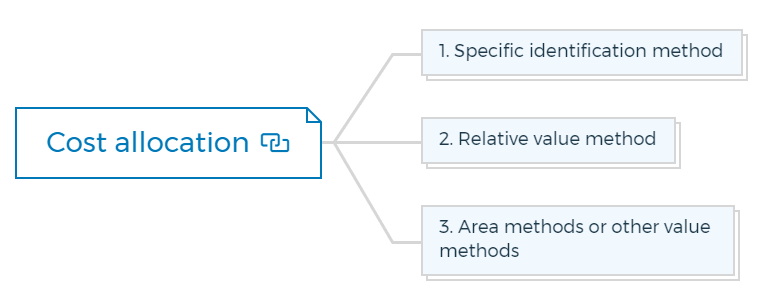
There are three methods to cost allocation -
1. Specific identification method
Whenever possible, expenditures are ascribed to specific components of a project. The specific identification approach is most commonly used in minor projects to allocate acquisition and direct construction expenses.
2. Relative value method
This strategy allocates expenditures based on the relative fair values of the project's components, either before construction or after.
3. Area methods or other value methods
The area technique allocates expenditures depending on lot size, structure square footage, or the number of units in a development. You should use the area approach only when using relative value methods would be impractical or impossible.
Selling costs in real estate accounting
The costs of selling a real estate project are usually high. Selling costs can be accounted for one of three ways:

1. Included in project costs
If all of these criteria are met, selling charges are included in project costs:
- They are intended to be recovered via the project's sale or from accidental operations.
They are incurred because of:
- Tangible assets that are immediately employed to aid in the sale of the project throughout the selling period, or
- Services are rendered to secure regulatory approval for a sale.
2. Deferred costs
Notably, deferred selling charges are not included in project costs. Selling charges do not increase a project's completion percentage if the percentage-of-complete approach is used. Deferred selling costs are also not eligible for interest capitalisation.
Selling costs are delayed as prepaid costs if they match the following criteria:
They must be directly linked to successful sales activities, and sales must be expected to recover them. In the accrual accounting method, selling costs are incurred in the sale period; therefore, there is no requirement for deferral.
3. Expensed costs
Costs that do not fit the criteria for project cost capitalisation or cost deferral are expensed as incurred.
Example of Selling Costs
You market developed land. You have established that the deposit accounting method is suitable because the buyers of the lots have paid only nominal down payments. You plan to defer the following four types of costs associated with your efforts to sell the lots:
- Salary and commissions paid to salespeople, as well as related insurance, taxes, and benefit
- Corporate sales department expenses
- Customer and prospective customer telephone, hospitality, dinners, and travel charges
- Professional costs and title insurance for the sale
You want to delay these expenses as they arise through the company's attempts to sell the lots. Is it reasonable to postpone these expenses?
- To the degree that sales personnel's salary and commissions are directly connected to successful sales efforts, deferring them (together with any related insurance, taxes, and benefits) is reasonable.
- Corporate sales department costs are not directly linked to successful sales and should not be postponed.
- Deferring telephone, hospitality, meals, and travel expenditures for customers and prospective customers is appropriate to the extent that they are incurred directly for successful sales activities.
- Because title insurance and professional costs are directly related to the sales, deferring them is reasonable.
Leasing costs
Costs to rent a property project fall into two categories: (1) initial direct costs and (2) other than initial direct costs.
Rent charges for direct financing or sales-type leases are considered selling costs.
Direct costs incurred by the lessor in negotiating and closing leasing arrangements and direct costs associated with specific operations undertaken by the lessor.
Other costs connected to and expected to be recovered from future rental operations are delayed (capitalised). Costs of:
- Model units and their decor
- Rentals
- Temporary signs
- Openings
- Rental flyers unused
Deferred rental charges are amortised throughout the lease term. Deferred rental costs that are not immediately tied to income are amortised over the estimated benefit period. It starts when the project is largely finished and ready for habitation.
If a lease or group of leases is likely to be terminated, all unamortised capitalised rental costs connected with those leases are charged to expense.
Non-advertising costs, such as general and administrative costs, are expensed as incurred.
Real estate income tax returns
Real estate income tax returns are different from those for other investments, so it's important to be aware of the differences while accounting for investment property.
For instance, rental income is considered taxable, but you can make many deductions against this. It includes -
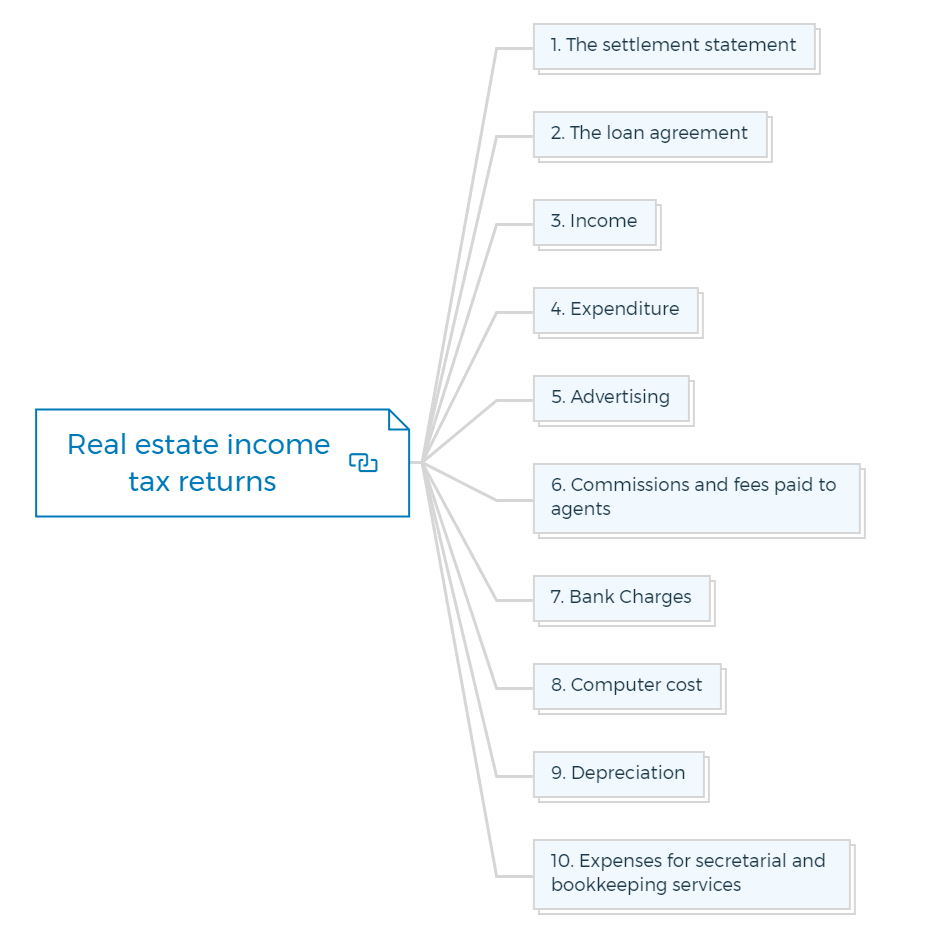
1. The settlement statement
Your solicitor will provide you with this statement when you finalize the property. It would need to be retained for at least five years after selling the property or until a loss could be offset against an assessable capital gain for five years.
2. The loan agreement
We use the loan document to keep track of the costs of borrowing. These are the fees associated with obtaining financing for the rental property.
You must carefully consider the way these are handled. If the sum is less than $100, it can be claimed in the payment year. If they exceed $100, they must be written off throughout the loan term or five years, whichever is shorter.
Borrowing costs include loan application fees, legal fees related to the mortgage, stamp duty on the loan, fees for document registration, title searches, mortgage registration, valuations, and mortgage insurance payments.
3. Income
It is the time to record the income for tax purposes. The taxable income you generate throughout a fiscal year is subject to income tax returns. Your taxable income is equal to your assessable income minus any permitted deductions you took during that period.
You can return income for tax with one of these two methods -
- The cash basis of property investment accounting - Income acknowledges as soon as it is received.
- The accrual method of property investment accounting - Money acknowledges as it is earned.
4. Expenditure
Ensure you are claiming just the allowable deductions. Not all expenses are tax-deductible. It would help if you distinguished between costs defined as capital and costs defined as an expense.
The property must be rented or offered for rent for an expense to be deducted. The costs of preparing a rental property for the first time are not deductible.
5. Advertising
The costs of promoting a rental property to find a tenant are deductible. The expenditures of advertising your home for sale are not deductible, but they will be deductible for CGT reasons.
So, if you pay your agent to publish a classified ad in the newspaper to find a tenant (or if you do it yourself), you can deduct the charges.
6. Commissions and fees paid to agents
The commission and fees paid to the agent are tax-deductible. It covers the commission paid to the agent, letting fees, and other fees. The agent will give you monthly statements that include these details.
7. Bank charges
Suppose you have a bank account dedicated entirely to property transactions. In that case, you may be able to deduct the costs of maintaining a bank account for banking rent and paying rental bills.
Use the bank statements to extract charges and recurring loan costs (such as loan service fees), which are also deductible.
8. Computer cost
You can claim computer costs if you keep property records on a computer. But you must allocate private usage. To do so, keep track of the time the computer is used for rental and personal purposes.
A one-month record may be sufficient. Software acquired expressly for rental property accounting should be claimed in total.
9. Depreciation
It permits you to write off some of the cost of the plant used to produce assessable income in a given year. You can calculate depreciation for tax purposes in two ways:
- Depreciation is calculated using the prime cost technique as a proportion of the plant's cost.
- The diminishing value technique is based on the asset's initial cost and then a proportion of the depreciated cost for subsequent years.
Most real estate investors employ a diminishing value basis since it delivers a higher claim in the early years. It exploits the notion that a dollar today is worth more than a dollar tomorrow.
To claim depreciation, you must own the item of the plant. You can't claim the tenant's furniture.
10. Expenses for secretarial and bookkeeping services
Maintain records for your rental property, including revenue and expenses. When submitting real estate tax returns, you can claim this income.
GST in property investment accounting
What is GST?
GST is a value-added tax levied on the consumption of most goods and services. Rental properties are considered taxable supplies for GST purposes, so landlords must charge GST on their rent.

However, you can claim many expenses as deductions against this.
The tax will have little impact on residential property investors' compliance needs than increasing non-financial expenditures. Commercial property owners face a unique set of challenges.
Residential Properties - Construction of new residences and renovations are subject to GST. Private sales of property are exempt from GST. Residential rents are subject to GST if the lease does not exceed 50 years. These rents are input taxed if the lease is less than 50 years
Input taxed
The term "input taxed" refers to the lack of a credit for taxes paid on products or services provided.
Input taxes apply to costs incurred in a residential rental property operation.
It implies that an investor cannot claim a tax credit for repairs, body corporate fees, rates (except water and sewerage), insurance, etc. But not for commercial properties.
Only the apartment will be input taxed if an investor owns a building with a shop on the ground floor and a flat above. GST will apply to the store.
Commercial Properties - Merchandise & non-residential land and buildings are taxed when built, sold, or rented. It applies to both new and utilized properties.
The owners of these properties are only tax collectors, as they can deduct the tax levied from the tax collected. They must, however, remit the GST charged to the Commissioner of Taxation on time.
CGT in accounting for investment properties
CGT is Capital Gains Tax, a tax on the profit you make when you sell an asset. For property investors, this includes any profits made from selling investment properties. CGT is calculated on the difference between the sale price and the original purchase price, minus any costs associated with buying or selling the property (such as agent's fees).
If you decide to sell one or more of your investment properties, you must understand the ramifications of CGT. Capital gains are only taxed if they exceed capital losses for the year.
In brief, subtract the purchasing cost from the sale price. However, there are adjustments for capital gains, such as depreciation, agent commissions, and property upgrades. If you own a property for 12 months or more, any gain is lowered by 50% for individuals and 33.33% for superannuation funds.
Capital losses can be adjusted against capital profits and carried forward forever. Property held as an investment comprises houses, flats, vacation homes, retail stores, and land. Your primary residence is exempt from CGT.

Get The Edge Now!
Discover the transformative power of our FREE EDGE platform and
unlock a world of opportunities at no cost!
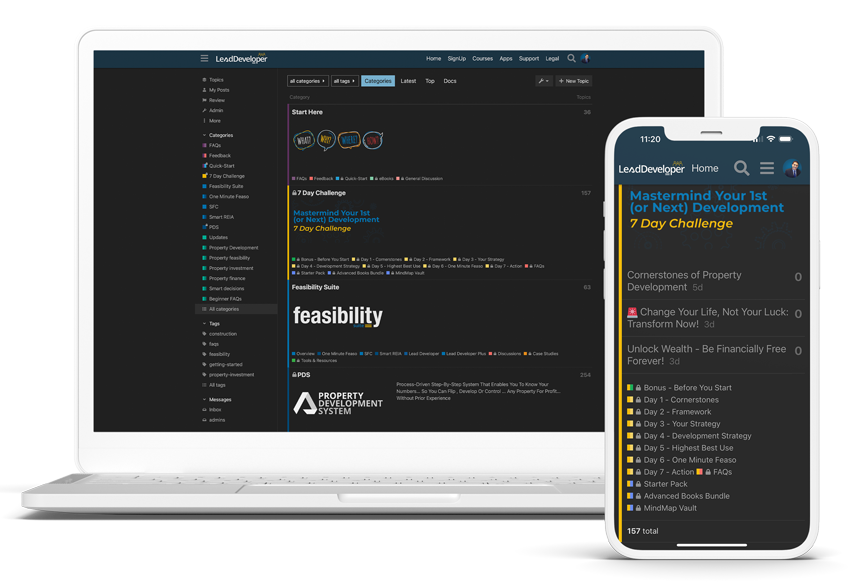
Your Real Estate Toolkit Awaits!
Free eBooks, Courses & Feasibility Suite Trial—Join Today!
✓ Unlimited FREE Trial: Experience the full power of our Feasibility Suite with hands-on demos
—explore without limits, no time pressure & without commitment or credit card!
✓ Learn from Success: Dive into real-life case studies for practical insights.
✓ Engage, Inquire, and Innovate: Ask questions, request features, and engage in lively discussions.
✓ Showcase Your Projects and Gain Insights: Share your projects and get personalised feedback.
✓ Free Resources Galore: Access a treasure trove of free resources,
eBooks & courses to keep you informed.
✓ Exclusive Training: Enjoy members-only training to sharpen your skills.
How to calculate CGT for a property sold?
The CGT calculation is based on the property's sale price minus your expenses.

The cost base is the initial asset price minus any incidentals, ownership and title charges, and depreciable goods.

- Stamp duty, legal expenses, agency fees, and advertising and marketing fees are examples of incidentals.
- Ownership costs include rates, land tax, upkeep, and loan interest.
- Improvements are replacing kitchens, bathrooms, and any other modifications you've made to the property.
- Annual depreciation is the amount claimed throughout the ownership of the leased asset. Any unclaimed depreciation reduces this value.
After calculating the capital gain, you can adjust the figure for variables such as:
- The percentage of time you owned the property that was rented out.
- A 50% discount is applied if the property is held for more than 12 months.
How can depreciation on property investment impact your taxes?
The reduction in the value of property assets over time is known as tax depreciation (also known as property depreciation). It is a valid deduction from taxable income earned by a residential or commercial investment property.
Two techniques are acceptable to pay tax. These are declining value and prime cost.
It estimates depreciation as a percentage of the depreciated value. The prime cost approach computes depreciation as a % of the cost.
The decreasing value basis provides the benefit of allowing a bigger deduction in the first years, resulting in lower tax. Except for part-year claims, the prime cost technique allows for an equal write-off each year.
To depreciate an item, the taxpayer must own it.

Calculation of depreciation
We calculate the claimable depreciation by the following formulas -
The formula for Diminishing Value Method

The formula for Prime Cost Method

Bookkeeping and recordkeeping
Do you keep books and records to support your tax claims? While keeping records for tax purposes is important, real estate investors require much more. They rely on reliable bookkeeping systems to ensure trend analysis and cash flow forecasts.
The significance of an audit trail and verification necessitates keeping books.

The audit trail refers to the bookkeeping system and how you may track the transactions in accounting.
The verification procedure starts with a final number on a financial statement and works backwards. That final figure is most likely the aggregate of several entries made throughout the year, each based on a single bank deposit, cheque, cash payment, or journal entry.
As a result, anyone looking at the final stage—the financial statement—should be able to verify information back to the source document—a receipt, deposit slip, contract, or other proof of that.
- the transaction occurred
- the amount is correct
- the transaction is business-related.
The figure below summarizes the audit trail.

- The final step, the financial statements, contains just summary data.
- The general ledger collects monthly account entries.
- Journals are collections of specific entries. There are four types of journals.
Obligation to keep record
The Tax law demands that you keep documents that detail your rental property transactions. It would help if you kept them -
- Either in writing or computer format, you should keep it in English only.
- So that you can easily determine your assessable income and permitted deductions.
- For five years after the invoice is issued or the completion of the transaction costs.
These records include your rental income and expenses and your rental property's acquisition or sale paperwork. The records must be produced if asked, even if they are not needed to be filed with your income tax return.
Leveraging in real estate
Leveraging occurs when you borrow money to fuel investment. Real estate is the only investment that allows you to leverage your borrowings readily.
Some lenders will even approve a loan with only a 10% deposit. You can deduct the loan interest and most property expenditures from your taxable rental income if you borrow money to buy an investment property.
If your property is available for rent, you can deduct the interest you paid on any loans you took out to buy, renovate, or deal with tenants.
The type of security used to secure the loan has no bearing on the interest deduction.
For example, securing your investment property loan with your home does not affect the interest tax deduction. However, the tax deduction is only possible if the borrowed funds are utilized to pay rent. If the funds were used for personal and business purposes, the tax-deductible amount would need to be apportioned.
Deductions for interest on mortgages and loans for rental properties are limited to the interest on the rental property. Similarly, if you take a loan to buy a property that is utilized for both rental and personal purposes, only the rental interest is deductible.
Most people buy their own home first, and then when their equity grows, they take out another loan to buy investment properties. They maximize the loan on the investment property to take advantage of the tax deduction on the interest charged.
Before accounting for property investment, consider whether you want to negatively gear (create a capital growth real estate) or positively gear (create a cash-flow real estate).
Both techniques have benefits and drawbacks, and which one you choose will depend on your unique circumstances and investment approach.

Negatively geared property
Negative gearing is often called "capital growth property." Buying a property with the expectation that it would appreciate over time. If you are in a higher tax bracket, the investment-related loss can be adjusted against other taxable income, lowering your tax bill.
If you choose this technique, look for an investment property in a stable, high-growth location near capital cities, which tend to do better over time.
Advantages of negatively geared property
Tax Deductions: Allowing investors to claim tax deductions for leasing expenses minimizes your rental deficit and thus your taxable revenue.
This is by no means an exhaustive list of what you can claim.
Before submitting your return, it is strongly advised that you seek professional assistance from a tax specialist.
- Tenant advertising, agent fees, and commission
- Payments of interest, loan fees, and bank fees
- Strata fees, land tax, and council rates
- Depreciation of appliances, including stoves, refrigerators, and furnishings
- Maintenance, repairs, pest control, and gardening
- Insurance for buildings and landlords
- Body corporate (owner's corporation) expenses and charges include stationery, phone bills, and any travel to check the property.
- Fees and costs for legal and accountancy services Government-imposed land taxes
- Postage and stationery
- Travel for the purpose of inspecting or maintaining the property or collecting rent
- Charges for water
- Improvements and capital works
Remember that there are some expenses for which you cannot claim a deduction: property acquisition and disposal costs, expenses not incurred by you, such as electricity charges paid by your tenants, expenses not related to the rental of a property, such as expenses related to your use of a vacation home borrowing expenses or interest on the portion of the loan you use for private purposes, such as buying a new car.
Capital Growth: To build wealth for investors, a property's capital returns must eventually balance the borrowing and costs.
Rental growth: As you raise the rent, the rental income exceeds the costs, resulting in a cash flow positive investment or a positively geared real estate.
Positively Geared Property
You have positive gearing when you collect more rent from your renters than you put out in loan repayments, property maintenance, rates, and other connected real estate expenses. Because the cash balance travels directly to you, this investment is known as a 'cash flow property.'
Advantages of positively geared property
Increased income: As an investor, you will benefit from increased revenue from the real estate, allowing you to pay down your mortgage faster and retire sooner.
Less financial risk: If your financial situation worsens, the investment's income will meet the costs, and you won't be forced to sell under duress under unfavorable conditions.
Increased real estate portfolio: With the extra income and value, you can buy one or two investment properties to add to your portfolio or use them to balance off negatively geared investments.
Attractive to banks: Your bank would be pleased to help you with another loan to buy other investment properties in the future since your track record of reducing the mortgage displays solid financial planning and credibility.
Taxation for foreign investors
Australia's property industry has attracted and continues to draw foreign investors. Australian property is comparatively stable with robust growth compared to other global property markets. Australian property values have performed substantially better overall compared to other wealthy countries.
A foreign investor is defined as a person who is not an Australian resident (non-resident/foreign national) who purchases the property, a business, or a corporation in which he owns 15% or more of the property, or more than one foreigner owns 40% or more of the property jointly.
A foreign investor or buyer typically fits into one of three categories:
- A foreigner having permanent residency in Australia who wants to acquire an Australian investment property
- A foreigner or non-permanent resident wanting to buy an Australian property
- A non-resident foreigner is looking to buy Australian property.
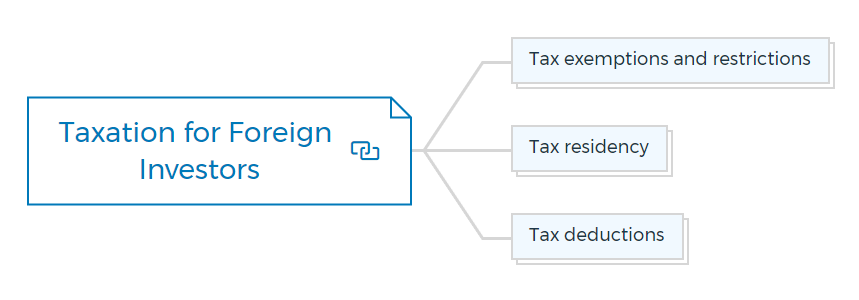
Tax exemptions and restrictions
Foreign investors purchasing property in Australia must first receive approval from the Foreign Investment Review Board (FIRB). The FIRB is an Australian government agency that oversees the sale of Australian property to foreigners.
Without an exemption, foreigners purchasing residential or commercial property in Australia must obtain FIRB approval, regardless of the property's value or the purchaser's nationality. Some acquisitions, however, are free from FIRB approval. Some examples:
- A Kiwi buying a home in Australia
- A foreign national buying a house as a joint renter with an Australian citizen spouse
- a new home offered by a developer with previous approval to sell to a foreign national
- A foreigner purchases an interest in constructed commercial property for immediate industrial or non-residential commercial usage.
Tax residency
If you are a foreigner buying property in Australia, you must determine your tax residency status. Tax residency requirements are complex and differ from immigration residency rules. You may be treated as an Australian tax resident.
If you are a tax resident in Australia, your international income is normally taxable in Australia. Otherwise, only income earned in Australia is taxable, and most overseas income is not, although you will be subject to Australian income tax and CGT on any Australian taxable property you possess.
Also, you must implement any Double Tax Agreement (DTA) Australia has with your place of residency.
Tax deductions
If you are a foreign resident and earn rental income in Australia,
(a) Obtain a tax ID number
(b) File a tax return in Australia.
As a taxpayer, you must report the rental income and can deduct several related expenses. If you sell your Australian property, you must pay capital gains tax.
Real estate accounting challenges
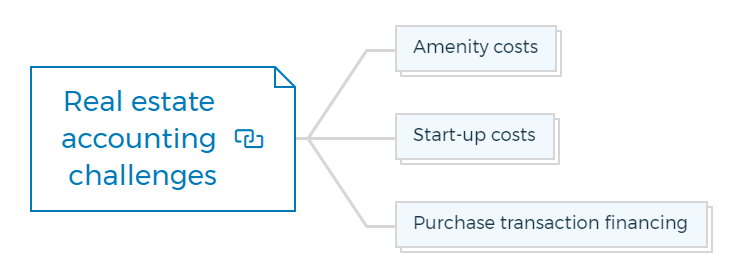
Amenity costs
Facilities that benefit or enhance a real estate project are commonly utilised as a marketing tactic by developers, especially in a slow real estate market. Golf courses, swimming pools, lakes, parks, and marinas are desirable amenities.
Amenities may or may not be profitable. These are either sold or transferred with individual units or retained and operated by the developer. Clubhouses, for example, may be sold to a homeowners association, whereas golf courses may be retained and operated by the developer.
Start-up costs
These are one-time activities such as opening a new building, developing a new product or service, expanding into new markets or attracting new customers, initiating a new procedure, creating a new company, or starting a new operation. Start-up costs are expenses incurred in connection with start-up activity.
A merchant may build a new storage facility. During the facility's completion and the store opening, start-up activities such as stocking inventory, training workers, and testing registers are often performed.
These expenditures are not part of the facility's acquisition, development, or building costs; they are start-up costs.
A cost is classified as a start-up if it is incurred before operations begin or after operations begin but before typical productive capacity is reached.
Purchase transaction financing
Financing is frequently a crucial aspect of real estate acquisitions. The seller may offer finance to the buyer, or the buyer may accept the property's mortgage.
There is a presumption that the stated interest rate is fair and adequate when funding is supplied in an arms-length transaction. When this presumption is inappropriate,
- There is no stated interest rate on the note
- The reported interest rate is too high.
- The stated face amount of the note (plus any down payment) differs considerably from the current cash sales price for comparable property.
- The note's stated face amount differs significantly from its market value at the transaction time.
If financing is granted at unreasonable rates, the property should be recorded at either its fair value or an amount that approximates the market value of the note plus the fair value of any other consideration provided to the seller, whichever is more easily determinable.
Suppose no documented exchange values or market value for the note. In that case, you should calculate the present value of the note by discounting all future payments on the note using an imputed rate of interest.
At the time of the transaction, the rate used to calculate the present value of the note should be equivalent to or close to the rate at which the debtor might obtain financing from other sources.
Bottom line
Property investment accounting requires you to take advantage of the ATO's tax breaks. Real estate investment has certain distinct tax advantages over other investments; therefore, taking advantage of these tax benefits will help you maximize your investment return.
The idea is to use negative gearing, deductions, and depreciation allowances to leverage your asset and increase its value over time.
Real estate investment has many potential tax benefits, but there are certain risks to avoid. If you sell your property, you must consider CGT. If you own real estate, engage closely with a qualified real estate accountant who can advise you on tax difficulties specific to your financial situation.
Enroll for property mastermind and get the insider knowledge you need for your next project.
If you want to get started on your own, check out our property development feasibility suite. This tool will help you estimate your next project's potential return on investment.
FAQs

